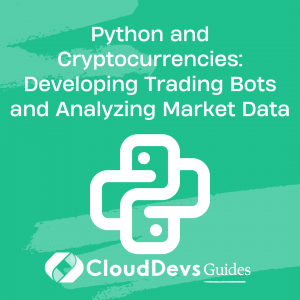Python and Cryptocurrencies: Developing Trading Bots and Analyzing Market Data
Table of Contents
Cryptocurrencies, such as Bitcoin, Ethereum, and Litecoin, have gained a lot of popularity in recent years. With the growing number of people interested in trading cryptocurrencies, there has been an increased demand for tools to help traders analyze the market and execute trades automatically. In this blog post, we will explore how Python can be used to develop trading bots and analyze market data for cryptocurrencies.
1. Getting Started with Cryptocurrency APIs
The first step in building a trading bot is to obtain data on cryptocurrency prices and market trends. This can be done using APIs provided by cryptocurrency exchanges, such as Binance, Coinbase, or Bitfinex. These APIs allow developers to programmatically access the data provided by the exchanges.
In Python, the requests library can be used to send HTTP requests to the API endpoints and obtain the data. For example, the following code retrieves the latest Bitcoin price from the Coinbase API:
import requests
response = requests.get('https://api.coinbase.com/v2/prices/BTC-USD/spot')
data = response.json()
price = data['data']['amount']
print(f"Bitcoin price: ${price}")
2. Developing a Trading Bot with Python
Once we have access to market data, we can start developing a trading bot. A trading bot is a program that automatically executes trades based on predefined rules. In order to develop a trading bot in Python, we need to choose a cryptocurrency exchange and its API to interact with.
In this example, we will use the Binance API to develop our trading bot. Binance provides an extensive set of APIs that allow developers to access data and execute trades programmatically.
To use the Binance API, we need to first obtain an API key and secret from the Binance website. We can then use the python-binance library to interact with the API. The following code shows how to retrieve the current Bitcoin price and place a buy order for a specified amount:
from binance.client import Client
api_key = 'YOUR_API_KEY'
api_secret = 'YOUR_API_SECRET'
client = Client(api_key, api_secret)
symbol = 'BTCUSDT'
quantity = 0.001 # Buy 0.001 BTC
# Get the current price
ticker = client.get_symbol_ticker(symbol)
price = float(ticker['price'])
# Place a buy order
order = client.create_order(
symbol=symbol,
side=Client.SIDE_BUY,
type=Client.ORDER_TYPE_LIMIT,
timeInForce=Client.TIME_IN_FORCE_GTC,
quantity=quantity,
price=price
)
print(order)
3. Analyzing Market Data with Python
Once you have collected the data, the next step is to analyze it using Python. There are many libraries available to perform technical analysis on financial data, including Pandas, Numpy, and Matplotlib.
To get started, you need to import these libraries into your Python environment. You can install them using pip, which is the package installer for Python. Here’s an example of how to install and import the libraries:
pip install pandas numpy matplotlib import pandas as pd import numpy as np import matplotlib.pyplot as plt
Once you have imported the libraries, you can start analyzing the market data. Here are some common techniques used in technical analysis:
- Moving Average: This is a simple technique that involves calculating the average of a set of prices over a specific time period. It can help to smooth out the fluctuations in price and identify trends.
- Relative Strength Index (RSI): This is a momentum indicator that measures the magnitude of recent price changes to evaluate overbought or oversold conditions in the price of an asset.
- Bollinger Bands: This is a volatility indicator that uses a moving average and standard deviation to identify possible overbought or oversold conditions in the price of an asset.
You can use these techniques to create charts and graphs that visualize the data and help you to make informed decisions about trading strategies. Here’s an example of how to create a simple moving average chart using Python:
# Load data into a Pandas dataframe
data = pd.read_csv('market_data.csv')
# Calculate the 50-day moving average
ma = data['Close'].rolling(window=50).mean()
# Plot the data and the moving average
plt.plot(data['Date'], data['Close'], label='Price')
plt.plot(data['Date'], ma, label='50-day Moving Average')
plt.legend()
plt.show()
4. Conclusion
Python is a powerful tool for developing cryptocurrency trading bots and analyzing market data. With the help of various libraries and APIs, traders can collect, analyze, and act on market data in real-time. However, it is important to note that trading cryptocurrencies can be risky, and it is recommended to approach it with caution and do thorough research before making any investment decisions.


